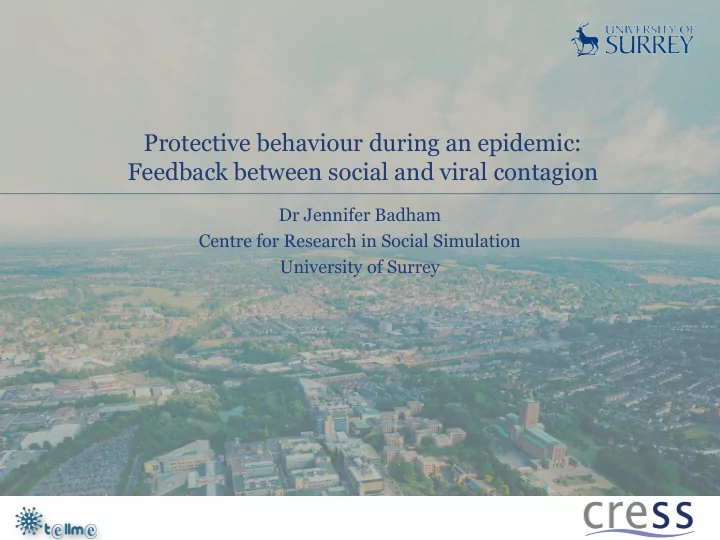

Protective behaviour during an epidemic: Feedback between social and viral contagion Dr Jennifer Badham Centre for Research in Social Simulation University of Surrey
Model context TELL ME: European funded project about communication during an epidemic – Simulation is one of the outputs – Other partners developing communication kit Help health agencies plan communication – enter details of epidemic scenario • severity, vaccine delay, hand washing efficacy etc – try out communication plans • packages of messages – compare the effect of the communication package on epidemic size Acknowledgement: This research has received funding from the European Research Council under the European Union's Seventh Framework Programme (FP/2007-2013), ERC Grant Agreement number 278723.
Broad model logic Abstract model to examine the interaction between protective behaviour and epidemic – Simplified version of TELL ME model • all communication removed Two component models with mutual feedback: – Spatially explicit difference equations for viral contagion – Agent based model for protective decision making • Includes social contagion of behaviour as norms is part of decision – Feedback process: protective behaviour epidemic spread threat perception protective behaviour
Two component models (detail) Difference equations to run epidemic ABM: agents adopt/drop protective – SIR compartment model behaviour if weighted average of three factors above/below threshold • counts for each disease – Attitude: uniform [0,1] state distribution – Each location / patch runs – Norms: proportion of visible own SIR counts agents with behaviour • Some travel – Threat: discounted – Infectivity reduced where cumulative visible incidence protective behaviour adopted Heterogeneity: – Attitude within location – Norms / Threat location specific
Automatic control of epidemics Ideal world: – Norms exaggerate response to threat, so that protective behaviour ‘gets ahead’ of the epidemic front and contains the disease – After the epidemic ends, protective behaviour stops Objective: – Is there a suitable combination of behaviour input parameters to allow this ‘automatic’ control? • Weights, incidence discount, threshold for adoption – If so, how large (in parameter space) is the suitable combination? • Is it easy to find, so intervention not required?
Experimental Design – full parameter space Approach: Simulations that focus on interesting parameter space – Thresholds – Weights and incidence discount 39 combinations of weights: – Weights for norms, threat and attitude sum to 1 – Norms and Threat weights in range [0.2, 0.5] by 0.05 – Attitude weight in range [0.2, 0.6] For each set of weights, 120 sets of other parameters – Threshold in {0.2, 0.3, 0.4, 0.5, 0.6, 0.8} – Efficacy in {0, 0.25, 0.5, 0.75, 1} – Discount for cumulative incidence in {0.02, 0.04, 0.08, 0.12} Single run for each parameter combination (work in progress) – R 0 = 4 to ensure epidemic – recovery period 5 ticks, 30% travel transmission with 85% in neighbours
Protective decisions can influence epidemic Individuals respond, but behaviour useless so epidemic has natural curve As behaviour more efficacious, adoption leads to delay in epidemic peak and reduction in its size.
Protective decisions can influence epidemic Individuals respond, but behaviour useless so epidemic has natural curve As behaviour more efficacious, adoption leads to delay in epidemic peak and reduction in its size. Hence, reasonable to expect suitable parameters would assist epidemic control
Three types of behaviour responses to epidemic Behaviour adopted, but maintained indefinitely Behaviour never adopted, so unable to control epidemic
Three types of behaviour responses to epidemic Behaviour adopted, but maintained indefinitely Behaviour never adopted, so unable to control epidemic Need thresholds where behaviour responds but then abandoned
Adoption threshold: full parameter space Note: Assumes uptake and drop behaviour at same threshold value Only mid range threshold values show behaviour being adopted and then dropped: – Low threshold (≤0.3, darker blue) and behaviour maintained – High threshold (≥0.6, darker red) and behaviour never adopted
Adoption threshold: full parameter space Note: Assumes uptake and drop behaviour at same threshold value Only mid range threshold values show behaviour being adopted and then dropped: – Low threshold (≤0.3, darker blue) and behaviour maintained – High threshold (≥0.6, darker red) and behaviour never adopted Only applies to subset of weight combinations
Focus on relevant weight combinations Want bottom left corner: – Bottom is small epidemic – Left is behaviour dropped after peak
Focus on relevant weight combinations Want bottom left corner: – Bottom is small epidemic – Left is behaviour dropped after peak Limited feasible parameter space: – Norms weight ~0.4 – Incidence (threat) weight ~0.2 – Attitude weight ~0.4
Multiple simulations in feasible space Again, want bottom left corner. – Some apparent solutions
Multiple simulations in feasible space Again, want bottom left corner. – Some apparent solutions BUT: behaviour isn’t being dropped: – Epidemic controlled quickly – Part of population never adopts behaviour
Conclusions: Problem No parameter set appears to allow automatic control of epidemic: – Need relatively high weight for norms in behaviour decision so that behaviour adopted ahead of epidemic – But behaviour then maintained despite end of epidemic Social and psychological processes reinforce behaviour – System behaviour here is an example of the ‘Social amplification of risk’ • Kasperson et al (1988). “ The social amplification of risk: A conceptual framework”. Risk Analysis , 8, 177-187. – Norms attenuate risk perception early in epidemic • Other people aren’t worried, so I must be over -reacting – Norms amplify risk perception post epidemic • Other people are still …, so I should
Conclusions: Potential solutions Model ‘correct’ → Communication essential – Authoritative recommendations – Triggers adoption and abandonment Model structure for behaviour decision incorrect? – Weighted average is simplest implementation of various psychological models of cognitive behaviour – Could reduce norms weight over time • Difficult to justify Perception of decision making agents incorrect? – Currently ‘see’ average threat and behaviour in 3 patch distance – Could see maximum threat and average behaviour (for example)
Recommend
More recommend